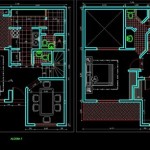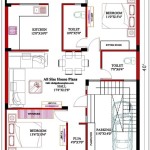Essential Aspects of Electrical Layout Plan House
An electrical layout plan for a house is a detailed blueprint that outlines the placement and wiring of all electrical components within the home. This plan is essential for ensuring that the electrical system is safe, efficient, and meets the specific needs of the occupants. Here are some of the key aspects to consider when creating an electrical layout plan for a house:
1. Load Calculations: The first step in creating an electrical layout plan is to calculate the electrical load for each room in the house. This calculation determines the amperage and voltage requirements for each circuit and helps ensure that the electrical system can handle the anticipated electrical demand. Load calculations are based on factors such as the number of appliances, lighting fixtures, and other electrical devices in each room.
2. Circuit Design: Once the electrical load has been calculated, the electrical layout plan can be designed. The plan should include the location of all electrical outlets, switches, lights, and other electrical components. It should also indicate the type of wiring used, such as NM cable or conduit, and the size of the wires.
3. Electrical Panel: The electrical panel is the central distribution point for electricity in the house. The layout plan should indicate the location of the electrical panel, as well as the size and capacity of the panel. The panel should be accessible for maintenance and upgrades.
4. Grounding and Bonding: Proper grounding and bonding are essential for electrical safety. The layout plan should include the location of all grounding and bonding conductors, as well as the grounding electrodes.
5. Safety Features: The electrical layout plan should incorporate safety features such as ground fault circuit interrupters (GFCIs) and arc fault circuit interrupters (AFCIs). These devices help protect against electrical shocks and fires.
6. Code Compliance: The electrical layout plan must comply with all applicable electrical codes. These codes ensure that the electrical system is safe and meets industry standards.
7. Future Expansion: The electrical layout plan should consider future expansion and upgrades. The plan should include provisions for additional circuits and outlets to accommodate future additions or renovations to the home.
Creating a comprehensive electrical layout plan for a house is essential for ensuring a safe, efficient, and reliable electrical system. By considering these key aspects, homeowners can ensure that their electrical system meets their needs and complies with all applicable codes.
Free House Wiring Diagram Edrawmax
It S Electrical
Electrical Drawing Blueprints Plan Layout Floor
Free House Wiring Diagram Edrawmax
Electrical Plan Examples And Templates To Kick Start Your Project
House Electrical Plan Diagram Symbols
Free House Wiring Diagram Edrawmax
Electrical House Plan Details Engineering Discoveries Wiring Diagram Home
House Wiring Diagram Everything You Need To Know Edrawmax
Electrical Plan Layout Floor Drawing








